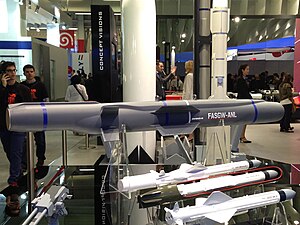| Sea Venom Anti-Navire Léger | |
|---|---|
 | |
| Type | Anti-ship missile |
| Place of origin |
|
| Service history | |
| In service | 2026 (Royal Navy - projected) |
| Used by |
|
| Production history | |
| Manufacturer | MBDA |
| Specifications | |
| Mass | 120 kg (260 lb) |
| Length | 2.5 m (8 ft 2 in) |
| Diameter | 200 mm (7.9 in) |
| Warhead | HE semi‐armour piercing blast/fragmentation |
| Warhead weight | 30 kg (66 lb) |
Detonation mechanism | Impact, time delay |
| Engine | Two‐stage solid‐propellant rocket motor |
Operational range | > 20 km (11 nmi; 12 mi) |
| Maximum speed | Mach 0.85 (289 m/s; 949 ft/s) |
Guidance system | INS, IIR |
Launch platform | |
| References | Janes[1] |
Sea Venom is an Anglo-French lightweight anti-ship missile developed by MBDA to equip the French Navy and the Royal Navy.[2] The missile is known as Anti-Navire Léger (ANL) in France and Sea Venom (formerly "Future Anti-Surface Guided Weapon (Heavy)") in the United Kingdom. While initial operating capability had been expected with the Royal Navy in 2022, it was reported in 2023 that, due to "on-going integration challenges", the Royal Navy's Wildcat helicopters would only achieve full operational capability with the missile in 2026.[3][4][5][6][7] The first test launch, from an AS365 Dauphin helicopter of the French DGA, was successfully conducted on 21 June 2017.[8][9]
Design
[edit]Sea Venom is designed as a successor to the French Navy's AS 15 TT and Royal Navy's Sea Skua missiles. When in service, Sea Venom will equip Eurocopter Panther and NH90 helicopters in the French Navy and Wildcat helicopters in the Royal Navy. Due to shared characteristics with its predecessors, MBDA claims Sea Venom will be able to readily integrate onto platforms that are already carrying Sea Skua and AS 15 TT.[2]
Much like its predecessors, Sea Venom is designed to attack surface targets, such as fast in-shore attack craft ranging in size of between 50 and 500 tonnes, as well as larger surface targets of up to corvette size. With its 30 kg warhead, the missile is also capable of inflicting significant damage to larger vessels through precision aim point selection, and can also attack static land-based targets. Whilst its precise range is currently unknown, MBDA has stated that the missile has a "long" stand-off range enabling it to be launched from beyond the reach of most modern air defence systems.[2] The missile is capable of several attack modes including sea skimming and "pop up/top attack."[10] Sea Venom uses an infrared seeker with the option of "man in the loop" track-via-missile guidance via data-link;[2] the high speed two-way data-link transmits the images "seen" by the seeker back to the operator, enabling them to remain in control of the missile throughout its flight in addition to having an autonomous engagement capability.[10]
MBDA is also working on a surface-launched variant of the missile.[8]
History
[edit]The Royal Navy declared Sea Venom an initial operating capability in May 2021 when it deployed them as part of United Kingdom Carrier Strike Group 21 on its maiden deployment to the Pacific. The missile equipped four Wildcat HMA2 helicopters embarked on the strike group's accompanying destroyers.[11] However, in 2023 it was reported that integration challenges were ongoing and, as a result, full operating capability would be delayed until 2026.[12] In October 2024, a Royal Navy Wildcat helicopter conducted a test-firing of the missile.[13]
The British share of the lifetime cost of the system was given as £945 million in 2022.[14][15]
See also
[edit]- Martlet (missile) - the "Future Anti-Surface Guided Weapon (Light)" equivalent
References
[edit]- ^ Janes (21 November 2022), "Sea Venom/ANL (FASGW[H]/ANL)", Janes Weapons: Air Launched, Coulsdon, Surrey: Jane's Group UK Limited, retrieved 2 January 2023
- ^ a b c d "SEA VENOM-ANL" (PDF). MBDA. Archived from the original (PDF) on 8 November 2014. Retrieved 12 December 2014.
- ^ "Royal Navy's Sea Venom light anti-ship missile full operating capability delayed until 2026". Navy Lookout. 21 June 2023.
- ^ "RN Wildcats field new anti-surface guided weapons for CSG21".
- ^ "The Martlet missile – the Wildcat helicopter gets its claws". www.navylookout.com. 15 June 2020.
- ^ "FASGW(H) / ANL" (PDF). Archived from the original (PDF) on 3 August 2014. Retrieved 12 December 2014.
- ^ Richard Scott (17 December 2018). "Sea Venom/ANL missile service entry faces year-long delay". IHS Janes. Retrieved 18 December 2018.
- ^ Hoyle, Craig (5 July 2017), "Anglo-French anti-ship missile completes first test", Flightglobal.com
- ^ Scott, Richard (24 May 2021). "RN Wildcats field new anti-surface guided weapons for CSG21". Jane's Information Group. Retrieved 29 September 2021.
- ^ "Royal Navy's Sea Venom light anti-ship missile full operating capability delayed until 2026". Navy Lookout. 21 June 2023.
- ^ Gray, James (14 October 2024). "Royal Navy Wildcat Test-fires Sea Venom Anti-Ship Missile". The Aviationist.
- ^ "Royal Navy's Sea Venom light anti-ship missile full operating capability delayed until 2026". Navy Lookout. 21 June 2023. Retrieved 15 September 2024.
- ^ Shelbrooke, Alec (8 September 2022). "Antiship Missiles: Procurement". UK Parliament. Retrieved 15 September 2024.
External links
[edit]